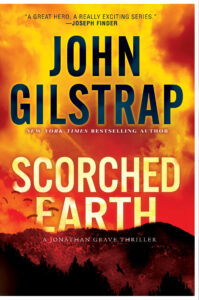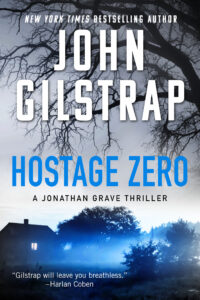By John Gilstrap
When Zero Sum, #16 in my Jonathan Grave thriller series hit the stands in 2024 as a “premium mass market paperback,” the paper copy retailed for $9.99 and the Kindle version cost $7.99. Fifteen books and as many years earlier, the standard mass market version of No Mercy, the first book in the series, retailed for $6.99, and for two weeks, the Kindle price was $0.00 before it skyrocketed to $2.99 after the promotional period expired*.
 This coming February, when Scorched Earth, #17 in the series is revealed to the world, it will be in a trade paper format. If you’re not familiar with the jargon, trade paperbacks have the dimensions and font size of a hardcover, but with soft covers. Paper copies will retail for $18.95 and the Kindle version will cost $9.99.
This coming February, when Scorched Earth, #17 in the series is revealed to the world, it will be in a trade paper format. If you’re not familiar with the jargon, trade paperbacks have the dimensions and font size of a hardcover, but with soft covers. Paper copies will retail for $18.95 and the Kindle version will cost $9.99.
For what it’s worth, I had nothing to do with this decision, and the decision itself isn’t about greed–at least not directly. Without wallowing too deeply in the weeds, the demand for mass market paperbacks has been dwindling for years, kept alive mainly by the reprints of last year’s bestsellers by big name authors. Those were the books you’d see in grocery stores and pharmacies and airports, but the real driver for the mass market were big box stores like Walmart and Costco, both of which announced that they would no longer be stocking their shelves with mass market paperbacks, with certain exceptions, including category romances.
This change concerns me. First of all, it’s change and I hate fixing things that don’t feel broken. I’ve always lived by the mantra, “Never try to make a happy baby happier.”
Trade paper has always been the format for literary fiction. At least that was the case in the United States. Thrillers were hardcover and mass market reprints. We are all creatures of habit. Will readers who generally trend toward hardcovers be more drawn to my books because they’re larger yet still softcover? Will mass market paperback readers who’ve reserved a specific spot in their briefcases for a small book be pissed off that they now have to carry something larger?
And there’s the price. Over the years, I’ve been blessed to be able to build a devoted fan base that’s willing to spend mass market prices for my stories. Will they stay with me as the price for the handheld book doubles? I guess I’ll find out. I worry less about my eBook fans because the price increase is less drastic, but it’s still change.
Now for the exciting part . . .
 The format change has provided an excuse to re-release all of my Grave series in trade paper format. No Mercy and Hostage Zero will hit the stands at the same time as Scorched Earth. While all the concerns remain, it’ll be nice to see out-of-print titles returning to the shelves.
The format change has provided an excuse to re-release all of my Grave series in trade paper format. No Mercy and Hostage Zero will hit the stands at the same time as Scorched Earth. While all the concerns remain, it’ll be nice to see out-of-print titles returning to the shelves.
Good news for autograph collectors. If there’s one complaint I’ve heard more than any other over the years about the mass market format is that bibliophiles who collect autographs don’t like the way small paperbacks look on their shelves. I understand that, actually. And as the man signing the autograph, I confess that I will be happy to have a larger signing area on the page.
 This brings us to the importance of pre-orders. I’m not a “please buy my book” kind of guy. I figure that if you have to beg, something’s wrong. In fact, I don’t even bring books with me to sell when I teach workshops. First and foremost, I’m not set up to be a retailer and have no desire to manage another layer of taxation. But also, I figure if I do my job right, people will be inspired to buy my books from a bookstore, or to borrow them from a library.
This brings us to the importance of pre-orders. I’m not a “please buy my book” kind of guy. I figure that if you have to beg, something’s wrong. In fact, I don’t even bring books with me to sell when I teach workshops. First and foremost, I’m not set up to be a retailer and have no desire to manage another layer of taxation. But also, I figure if I do my job right, people will be inspired to buy my books from a bookstore, or to borrow them from a library.
That said, if you’re inclined to buy my books when they come out, given the expanse of this change in the way of doing business, it would be extremely helpful for you to pre-order the book through your retail outlet of choice. Whether you prefer a physical book or an eBook, preorders send a message to the publisher and the marketplace in general.
So, what say you, TKZ family? How price sensitive do you think readers are? Are you going to miss pocket-size books?
=
*I’m proud to note that No Mercy shot to the #1 free book on Amazon, “selling” over 60,000 copies during that time. When the price returned to $2.99 the book remained the #1 overall Kindle bestseller for the next week. That was a promotional gambit that worked better than I’ve ever witnessed.

Ah, nostalgia. I remember seeing No Mercy on the new release rack at Barnes & Noble.
Mass market was a great format when there were spinner racks everywhere and shelf space in chain bookstores. The price was right. Then ebooks hit and the cheap reading experience passed to them (along with Kindle Unlimited for the most voracious readers).
I remember spinner racks and the enjoyment of twirling them to find an eye-catching title. Hardcovers were an expensive luxury except for chain store remainder bins where you dug through looking for three-year-old past bestsellers with slashed prices.
Bad eyesight, arthritis, and lack of storage space converted me mostly to Kindle for fiction. Hardcover is preferable for nonfiction and reference. I like trade paperbacks b/c the print is larger than MM. On plane trips, I always take a couple of physical books in case the Kindle runs out of battery cuz the seat charging ports never work.
The switch messes up my bookshelves for some favorite authors. I have no problem reading the hardcover from the library and then waiting for the MMPB to add to my collection.
My books in print are trade paperback, and for the longest time, I tried to price them competitively with MMPBs, but if that format is dwindling, maybe I’ll raise my price point.
And congrats on your award! Way to go!
“Messing up” my shelves with different sized books is not an issue for me. I just moved so all of my books are getting sorted and shelved. Since Elaine Viets has released books in hardcover, trade paperback, mass market paperback, and audio book (on cassette), the “Viets” section is in chronological, not size order.
My father would of loved Kindle. He kept a paperback or two in his coat and briefcase for any place he needed to be in line. I will miss them.
We have custom-made, floor-to-ceiling wall-mounted bookshelves sized for mass market paperbacks, which run along one wall of my writing room. My wife and I loved that format for its affordable and portability. Now we have kindles with thousands of ebooks, along with some fine hardcover and trade editions, but mass market paperbacks will always occupy a special place in our hearts.
I prefer my Kindle these days. However, I have many favorite novels of the Agatha Christie era also, and drag them out once in awhile.
I’ve preordered Scorched Earth, and am waiting impatiently for Feb.
And congrats on your LA award!
Happy Thanksgiving to all…
As long as the trade paperbacks fit on 9 1/4″ shelves. I’m fine. Anything taller has to compete for space on the hardback shelves.
I accept that’s the way industry has gone but it doesn’t make me happy. Trade paperbacks are neither fish nor fowl with glued bindings, soft covers and near hardback prices. Given my druthers, I’d pony up the extra and buy a hardback instead but if I can’t read the format I want I’ll read the format I’m with. I suspect I’m not unique in that.
This also means the end of the stripped cover “returns” from bookstores. For those unfamiliar, a bookstore will remove the cover of a mass-market and send it back for a full refund then supposedly throw away the rest of the paperback. Many of them end up in flea markets or the damaged book bins in used bookshelves.
I prefer Kindle for its storage capacity and font size change on demand. It’s especially convenient for library books—never a late charge. However, I like reference books and non-fiction in trade paperback size.
Sounds like No Mercy generated a lot of goodwill!
I love my John D MacDonald mass-market books but I prefer either trade or Kindle. And a soft cover is easier for me to hold.
I love my John D MacDonald mass-market books but I prefer either trade or Kindle. And a soft cover is easier for me to hold. Congrats on the award!